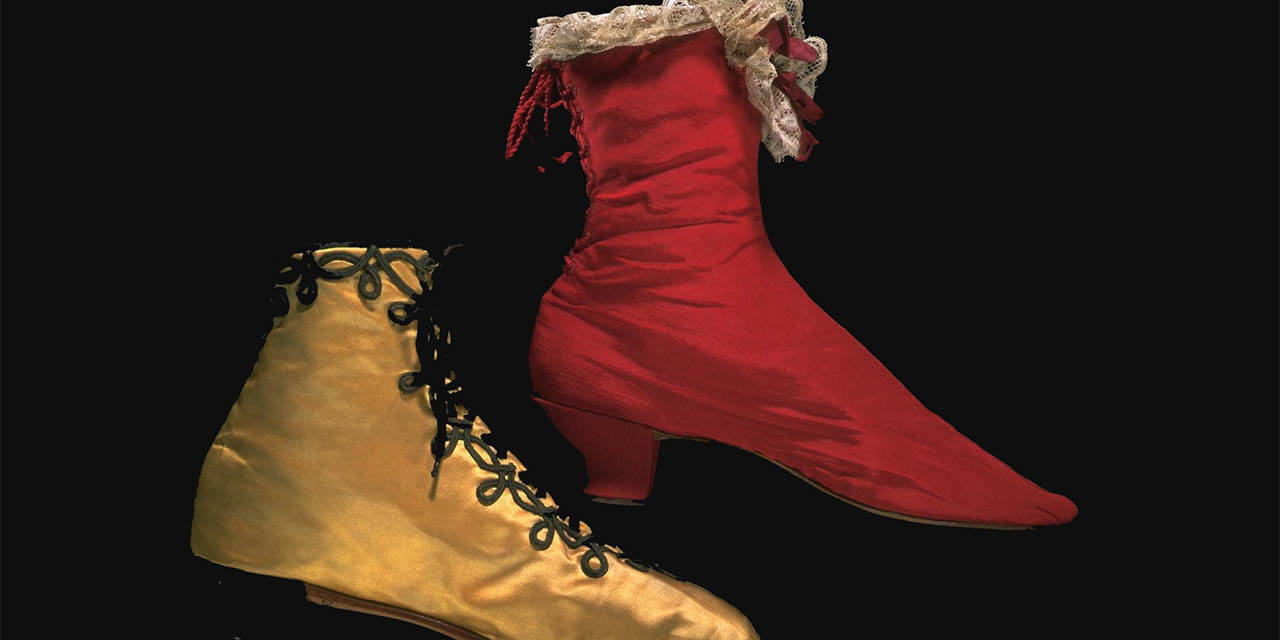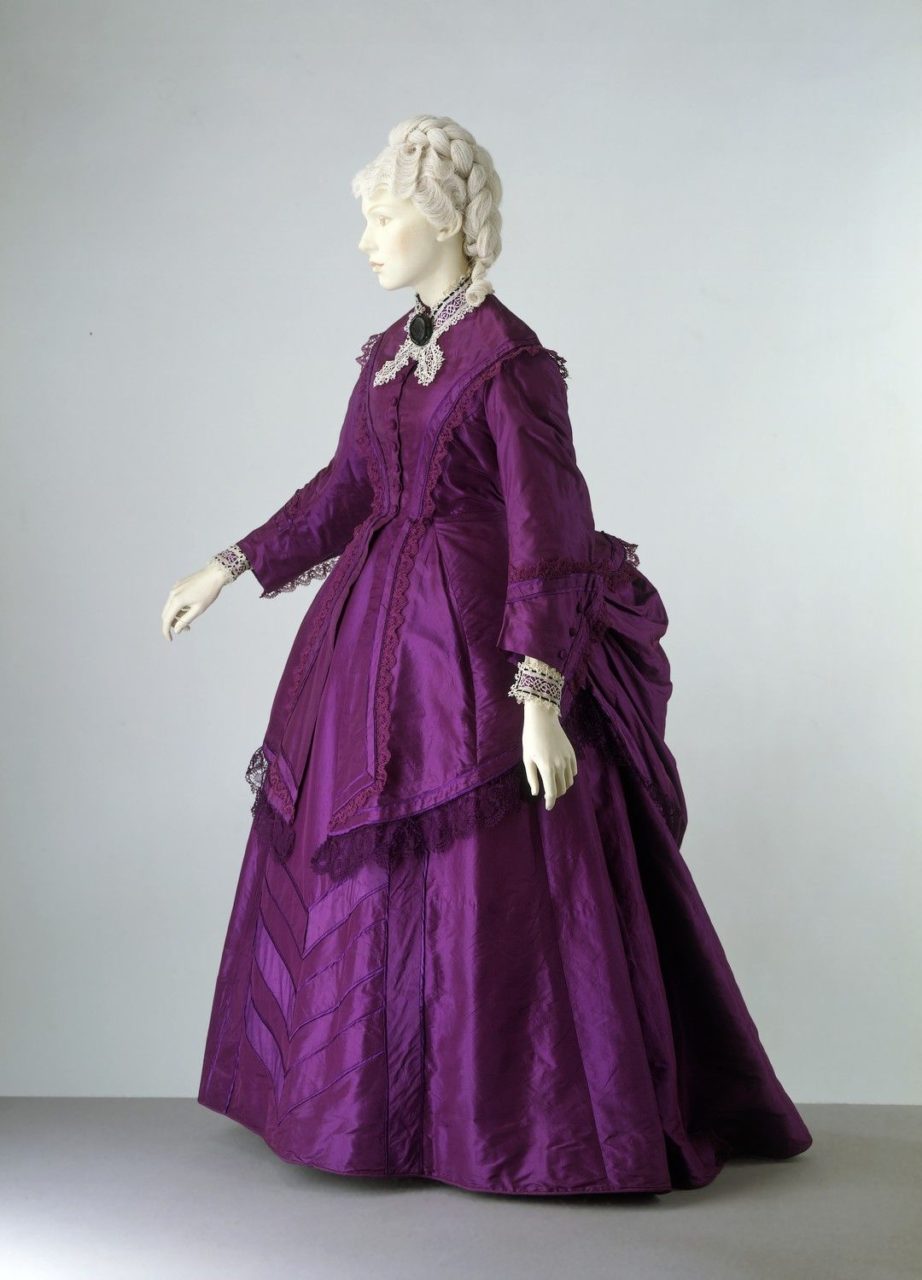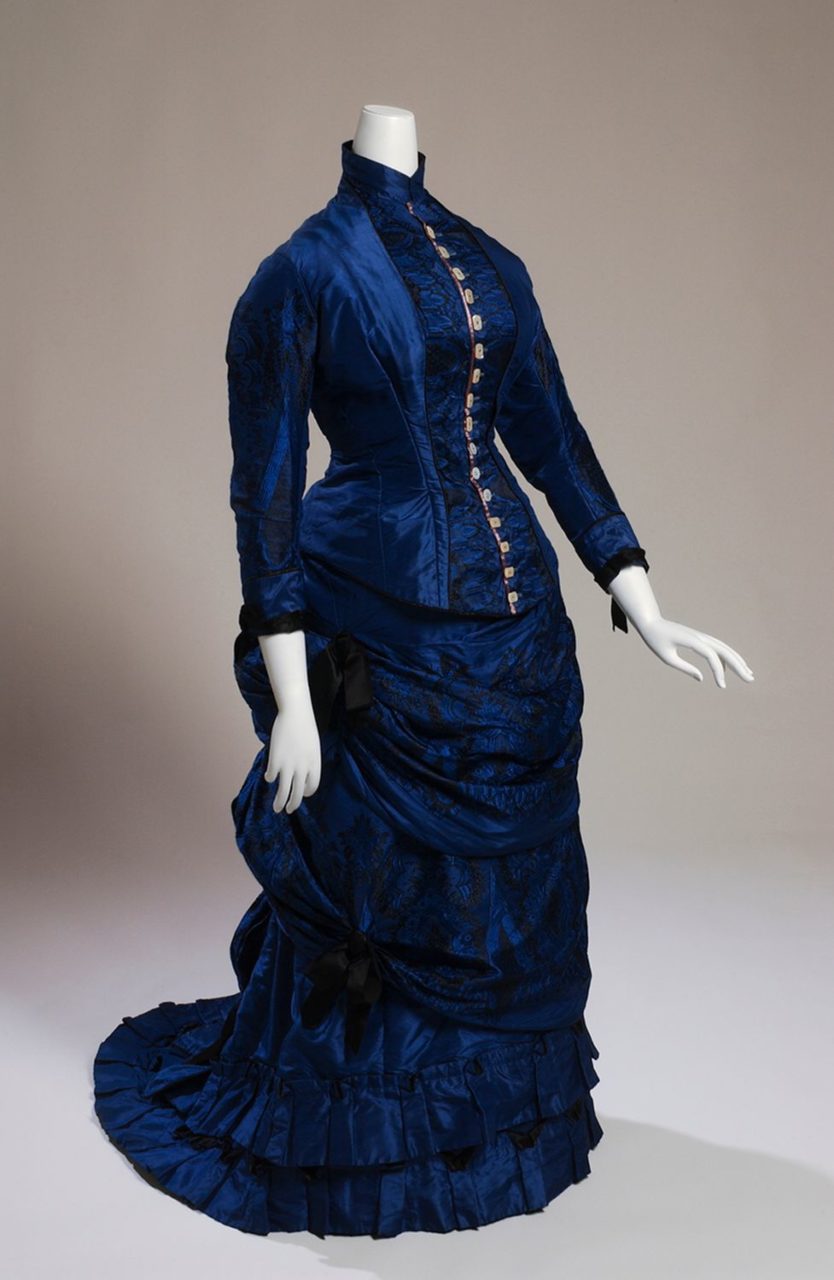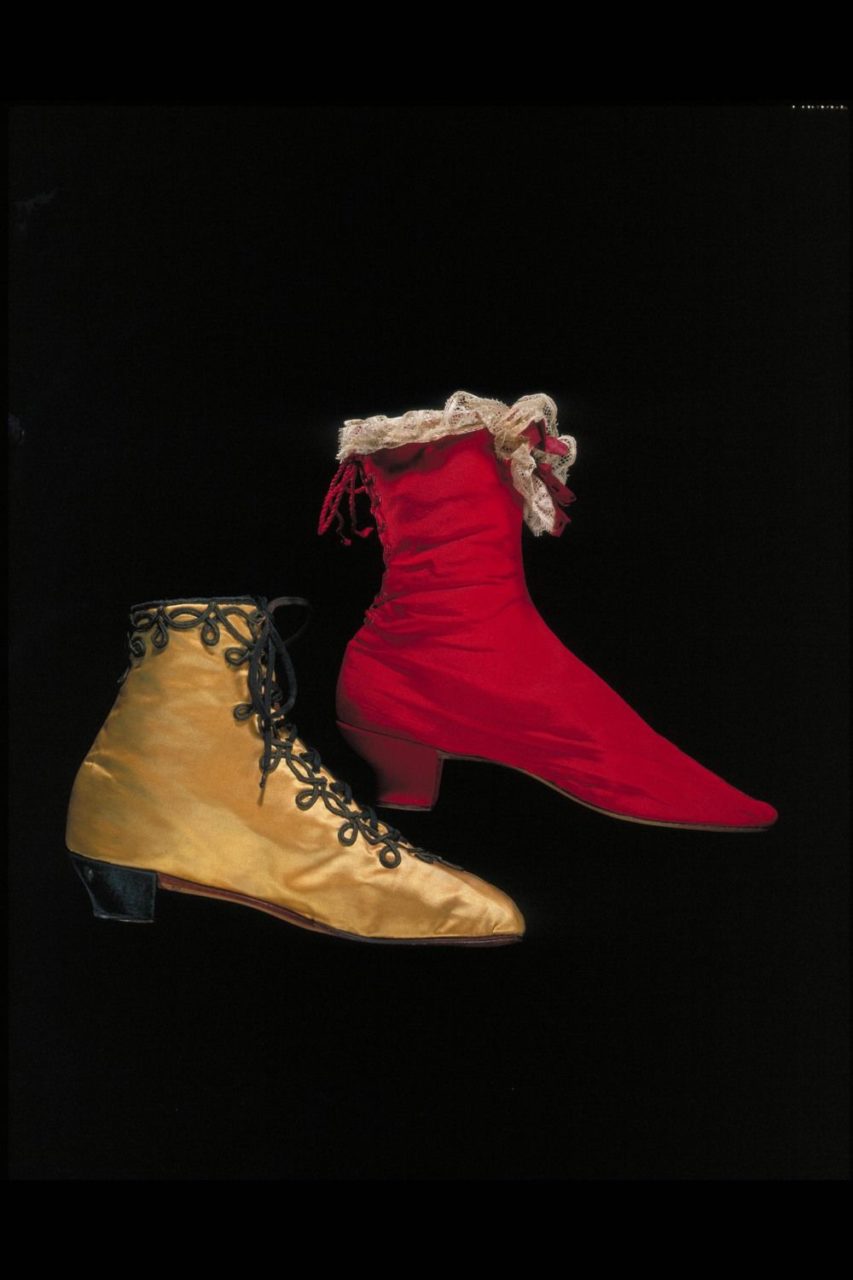Synthetic, chemical dyes for garments first invented in the 19th century.
The Details
The Victoria & Albert Museum explains the origins of aniline dyes while describing an 1870-73 aniline dress (Fig. 1):
“The technology of dyeing fabrics was transformed in the mid-1850s when the British chemist William Perkin (1838-1907) discovered that dyes could be extracted from coal tar. These new aniline dyes became very fashionable. The first was ‘Perkin’s mauve’, followed by a variety of shades of purples and magentas, yellows, blues, and pinks. These colours were much more intense than any available from the traditional natural dyes.”
Historian Daniel Delis Hill in the History of World Costume and Fashion (2011) gives a bit more detail:
“Other important development in the clothing industry included the discovery of aniline dyes in 1856 from which a rich palette of synthetic dyestuffs was produced, providing manufacturers and consumers with a vast array of color options.” (494)
Figures 1 and 2 represent day dresses of aniline dyed silk in different shades of purple. The Victoria & Albert Museum gives an extensive history of aniline dyes when describing the brilliant violet dress in its collection (Fig. 2):
“The ruched skirt and draperies on this dress reverberate with intense colour, revealing the fashion for bright new synthetic dyes. Their inception owes much to the work of Sir William Henry Perkin (1838-1907), who discovered the first famous artificial colour by accident in 1856 when he was a student at the Royal College of Chemistry in London. While experimenting with a synthetic formula to replace the natural anti-malarial drug quinine, he produced a reddish powder instead of the colourless quinine. To better understand the reaction he tested the procedure using aniline and created a crude black product that ‘when purified, dried and digested with spirits of wine gave a mauve dye’. This dye created a beautiful lustrous colour that Perkin patented and which became known as ‘aniline violet’ or ‘mauveine’.
Perkin’s discovery led to a revolution in synthetic colour from the late 1850s onwards. Textile manufacturers soon turned to his aniline process and the resulting fabrics were characterised by an unprecedented brilliance and intensity that delighted the consumer. Women’s dresses acted as a perfect advertisement for these rich hues, especially as trimmings usually matched the colour of the gown. In August 1859 the satirical journal ‘Punch’ described the craze for purple as ‘Mauve Measles’, a disease which erupted in a ‘measly rash of ribbons’ and ended with the entire body covered in mauve. Soon other synthetic dyes were being produced with evocative names such as ‘acid magenta’, ‘aldehyde green’, ‘Verguin’s fuchine’, ‘Martius yellow’ and Magdela red’ to match their gaudy appearance. Dye analysis of this dress showed that the silk was coloured with synthetic dyes belonging to the methyl violet and aniline blue families of dyes.”
In The Chemical Technology of Dyeing and Printing (1948), historian Ludwig Diserens and Paul Wengraf explain how William Perkin discovered the synthetic purple:
“Perkin made the experiment and there resulted in a black molasses-like mass, very far removed from the white crystal he was hoping for. But by testing this with various of chemicals, he found that hot alcohol dissolved part of it, and turned it into a violet liquid which had the power to dye silk and wool the same bright colour.” (55-56)
The afternoon dress shown in figure 3 was dyed in rich royal blue, a new kind of color made possible with aniline dyes in the later 1850s.
The Dictionary of Fashion History (2010) defines aniline dyes:
“Period: 1856 onwards. Dyes derived from coal tar which transformed the range of colours available for fabrics. The first synthetic dye was discovered by William Henry Perkin “(1838-1907)” whose aniline purple, better known as mauve, was an instant success and led to further discoveries.” (230)
The pairs of boots depicted in figure 4 were dyed in yellow and red, as the Victoria and Albert Museum describes:
“by about 1860 chemical aniline dyes were widely available. Many of the colours they provided were rather gaudy. The bright yellow of this pair of boots forms a striking contrast with the black braid.”
Notably labeling the colors “gaudy” perpetuates a bias born in the period that considered the new colors to be garish and to lack taste. Indeed the significance of colors shifted dramatically in the 19th century as a result, as Museum at FIT curator Emma McClendon explains:
“Before the first synthetic aniline dye was invented in the 19th century, all colors came from natural sources. The first aniline dye invented was mauveine, or purple, and it was a happenstance discovery.” In 1856, 18-year-old chemist William Henry Perkin was doing experiments for his professor, trying to synthesize the anti-malaria drug quinine. “He realized from these experiments that he was producing a powdery purple residue from certain chemical combinations. Before his discovery, purple was incredibly difficult to produce. It came from a particular species of snail and took a lot of the tiny animals to create a large enough quantity of purple dye to dye an entire dress, and it faded really, really easily, which is why that color was reserved almost exclusively for royalty and members of the clergy. They were the only people who could afford it. Not only was this new aniline dye fade-resistant and cost-effective to produce, it also changed the social status of the color purple. It lost its stigma and associations of being just for members of the royal family, and thereby changed the entire cultural coding of a society.” (Kim)
Fig. 1 - Designer unknown. Day dress, 1870-1873. Aniline dyed silk, lined with cotton, trimmed with satin and bobbin lace, reinforced with whalebone.. London: V&A Museum, T.182&A-1914. Given by Mr Leonard Shields. Source: V&A Museum
Fig. 2 - Designer unknown. Day dress, 1873. Silk and ruching; height: 1600 mm, width: 700 mm, depth: 1000 mm cm. London: V&A Museum, T.51&A-1922. Given by the Marchioness of Bristol. Source: V&A Museum
Fig. 3 - Designer unknown. Afternoon dress, 1878. Silk taffeta. New York: The Museum at FIT, MFIT-35. Gift of Bernice Margulies. Source: The Museum at FIT
Fig. 4 - Maker unknown. Pair of Boots, 1860s-1870s. Leather sole, and uppers of silk satin with applied silk braid.. London: V&A Museum, T.588&A-1913. Given by Messrs Harrods Ltd.. Source: V&A Museum
References:
- Cumming, Valerie, C. Willett Cunnington, Phillis Cunnington, Charles Relly Beard, and C. Willett Cunnington. The Dictionary of Fashion History. Oxford ; New York: Berg, 2010. http://www.worldcat.org/oclc/751449764. (page 230)
- “Day Dress | V&A Search the Collections.” V and A Collections, April 26, 2019. http://collections.vam.ac.uk/item/O13846.
- “Day Dress | V&A Search the Collections.” V and A Collections, August 9, 2019. http://collections.vam.ac.uk/item/O122391.
- Diserens, Ludwig, and Paul Wengraf. The Chemical Technology of Dyeing and Printing. Translated and revised from 2d German ed. 2 vols. New York: Reinhold, 1948. http://www.worldcat.org/oclc/624381311.
- Hill, Daniel Delis. History of World Costume and Fashion. Upper Saddle River, N.J: Pearson Prentice Hall, 2011. http://www.worldcat.org/oclc/939043732.
- Kim, Sara. “Ready-To-Wear Milestones At The Fashion Institute of Technology.” Creators (blog), April 16, 2013. https://www.vice.com/en_us/article/d74g7w/ready-to-wear-milestones-at-the-fashion-institute-of-technology.














